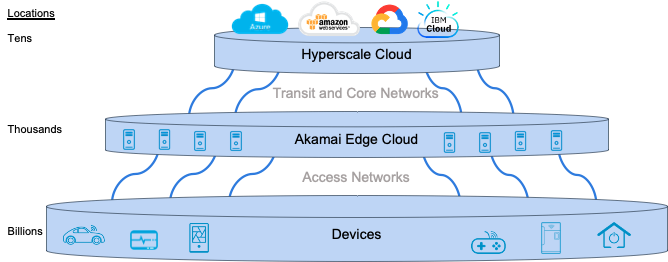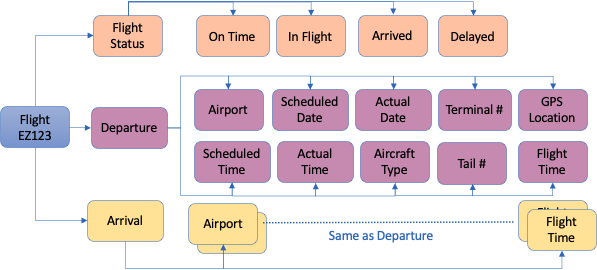Akamai Edge Cloud: Scaling IoT, Part 2

IoT has tremendous possibilities to transform our world but will fall short of expectations if the underlying infrastructure cannot support the rapid exchange of massive amounts of information from billions of simultaneous and intermittent connections. Akamai Edge Cloud is designed to enable the potential of IoT by utilizing the deep knowledge we've gained operating one of the world's largest edge networks.
Available to IoT and application developers, Edge Cloud is architected to solve the platform and infrastructure complexities of operating seamless logical services across multiple distributed data centers across the globe. Edge Cloud provides an underlying infrastructure that simplifies application design and handles encrypted connections at scale, data delivery challenges, and distributed data streams and processing. By tapping into a highly distributed worldwide network with massive scale, you can focus on developing applications that create value by leveraging IoT data collected and processed at the edge.

Edge Cloud enables a targeted suite of messaging, security, and processing options at the edge, which allows you to select the most appropriate execution model for the desired application. IoT generates vast quantities of data that needs to be cleaned, sanitized, and filtered or aggregated before being loaded into centralized models for further analysis. Processing that data at the edge, where it originates, enables faster insights and decision-making.
 Edge Cloud is built to deliver messaging, security, and processing. A seamless, distributed serverless platform, Edge Cloud eases the burden of creating and deploying applications that need to communicate securely at global scale.
Edge Cloud is built to deliver messaging, security, and processing. A seamless, distributed serverless platform, Edge Cloud eases the burden of creating and deploying applications that need to communicate securely at global scale.
Messaging
Edge Cloud provides a powerful and flexible messaging fabric that allows devices to easily communicate with each other in a variety of traffic patterns. The messaging fabric is backed by a distributed message broker that provides topology hiding, ensuring that devices can communicate, but are protected from each other. The broker follows the publish-subscribe model for large-scale data collection, group messaging around topics, and broadcast traffic patterns. Applications can be network- and data center-agnostic as the device opens a session with the serverless platform and is transparently connected to the nearest broker.
The message broker supports multiple protocols, allowing developers to leverage MQTT (for resource-constrained devices and applications), HTTP, or a combination of both. The messaging can be synchronous or asynchronous depending on the application need -- particularly useful for devices with intermittent network connectivity, allowing messages to be queued up and retrieved when the device comes back online. It is also possible to specify various message quality of service (QoS) levels for reliability and performance, such as high reliability for transactional application patterns or lightweight for short or frequent data.
We are working on enhancements to the messaging fabric to make it fully programmable, providing developers the flexibility to forward, filter, sample, replicate, aggregate, and transform messages and payload data right at the edge, close to where the devices create the information. Akamai supports ISO-based messaging standards for the development of messaging clients that are not confined to a proprietary messaging model or software development kit (SDK). This is especially important for embedded devices where resources can be heavily constrained.
Security
Security is a primary concern of any IoT service, and Edge Cloud has incorporated a comprehensive set of capabilities to ensure that your data, customers, and services are protected from existing and continually evolving threats.
Edge Cloud supports JSON Web Tokens (JWT) and X.509 certificates to ensure that the devices and edge are mutually authenticated to each other and authorized to use the requested services. A strong security posture aligns with Zero Trust principles and mitigates resource starvation attacks with built-in distributed denial-of-service (DDoS) protection.
Edge Cloud offloads centralized hyperscale clouds from the heavy workload processing of connection management, Transport Layer Security (TLS) encryption, authentication, and service and resource authorization. Akamai also provides a strong forward defense from security threats, so large-scale attacks won't overwhelm infrastructure or reach valuable applications and data. Data can be isolated to designated regions if desired, assisting customers with applicable data privacy regulations.
Processing
Edge Cloud provides a set of essential serverless processing capabilities to enable developers to build microservice applications without having to worry about the traditional challenges of managing virtualized server infrastructure configuration such as provisioning and dimensioning, routing, deployment, patching, maintenance, monitoring, or management. Developers can increase productivity and shorten development times by staying focused on the business value that their code delivers.
Serverless processing can be initiated directly on individual messages or applied to one or more message flows, enabling dynamic specification of the message paths (device-to-cloud, cloud-to-device, or device-to-device). The lightweight framework determines which flows and events should be inspected and can trigger more complex processing such as whether the data is passed on transparently, filtered, sampled, replicated, or rerouted.
The serverless framework can perform more complex tasks directed at the message payload in order to execute the necessary data validation and sanitization work. The data can be aggregated, filtered, and transformed as required by the application. These capabilities allow for the automated processing of the large amounts of data that IoT devices generate for a fully autonomous edge that is seamlessly merged with advanced message processing. The message flows can then be aggregated into a high-performance message stream that is forwarded to a hyperscale cloud of choice and used for analysis and model training with long-term storage in a data lake.
Customer Case Study: Global Airline Improves Operations
Airports can be chaotic environments, with critical information like airline name, flight number, terminal, gate, arrival/departure times, and flight status fueling efficient operations. Ensuring consistent and correct data for digital displays, mobile apps, and other notification systems requires complex traffic flows and large-scale data distribution.

With widespread operations and disparate IT systems, airlines face many challenges sending and synchronizing critical data. Inconsistent internet routing and varied network speeds make real-time data coordination even more difficult. Conflicting flight status information on various display devices causes passenger confusion and extra customer service demands -- efforts and costs that can be alleviated with more accurate and timely information distribution.
To solve this problem, a global airline leveraged Akamai Edge Cloud for the scale and performance required to deliver accurate data closer to the source across the airline's global locations. As shown in the figure below, the Edge Cloud broker publish and subscribe mechanisms provided structured design and robust topic-based implementation for reliable automated message delivery and notification in real time.

Structured data design, based on topics, streamlines application performance. Various display devices subscribe to the appropriate topic, and all of the subscribed clients receive automatic push notifications in real time, synchronized across all systems as soon as the information changes, eliminating any conflicts. This approach simplifies the number of systems involved and reduces the integration needed between multiple legacy systems while accommodating different end devices and systems.
Compared to the previous solution, Edge Cloud allowed the airline to achieve more consistent and accurate flight status information across various platforms. It streamlined all airport operations in real time -- for example, "gate change" notifications enabled all relevant parties including gate agents, ground crew, flight crew, and catering to receive coordinated updates for timely responses, effective decisions, and on-time departures. The solution significantly reduced traveler confusion and customer support requests, improving customer experiences and reducing airline costs.
Delivering on the Promise of IoT
IoT is transforming our world with compelling benefits that deliver significant value across all industries. The evolution in cloud architecture is key to providing the scale required to deliver on the promise of IoT, supporting valuable data-driven insights and positive business outcomes.
With more than a quarter of a million edge servers, deployed in thousands of locations around the world, the Akamai platform ingests 2.5 exabytes of data per year. The insight derived from operating this massively distributed, intelligent edge platform is leveraged to enable Akamai Edge Cloud to drive customers' digital transformations.
Akamai Edge Cloud secures and transports data in real time, optimizes scarce resources by processing data at the edge, and accelerates IoT performance by enabling decisions closer to end users. Learn more about how Akamai Edge Cloud can help you meet your IoT cloud infrastructure needs.






